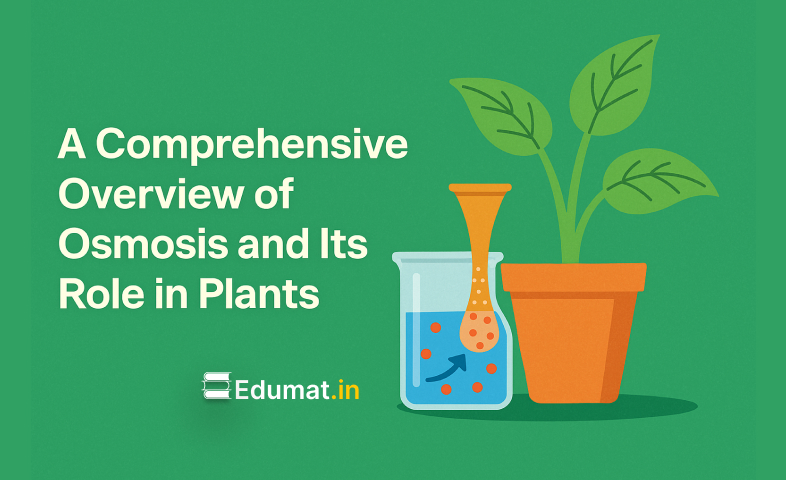A Comprehensive Overview of Osmosis and Its Role in Plants
Biology • June 12, 2025
Swaraj Barik

🌱 Introduction to Osmosis
Osmosis is a vital biological process where water moves across a selectively permeable membrane—from a region with more free water (or fewer solutes) to one with less free water (or more solutes). This movement continues until the water concentration on both sides becomes balanced.
It's a passive process, meaning it doesn't require energy. The side that pulls in water is called the osmotic sink, which has a lower water potential (more negative energy). Osmosis plays a key role in maintaining the water balance and pressure inside living cells, especially in plants.
Types of Osmotic Movements
There are two main types of osmotic flow:
- Endosmosis: Water enters a cell, making it swell.
- Exosmosis: Water leaves a cell, causing it to shrink.
These movements help maintain the shape and function of plant cells and tissues.
Osmotic Pressure and Reverse Osmosis
Osmotic pressure is the pressure needed to stop the natural flow of water into a concentrated solution. It depends on the solute concentration and is measured using devices like osmometers.
Typical osmotic pressure values:
| Plant Type | Osmotic Pressure (atm) |
|---|---|
| Aquatic plants | 1–3 |
| Mesophytes | 5–15 |
| Xerophytes | 30–60 |
| Salt-tolerant plants | Over 200 |
Reverse osmosis is the opposite of natural osmosis. It uses external pressure to force water through membranes, removing salts and impurities—commonly used in water purification and desalination.
Conditions Needed for Osmosis
For osmosis to happen, two main conditions must be met:
- A semi-permeable membrane that allows only water molecules to pass.
- A difference in solute concentration or pressure on both sides of the membrane.
For example, in lab experiments using a thistle funnel setup, water moves into the funnel until gravity balances the osmotic pressure.
Tonicity: Effects on Cell Volume
Tonicity refers to how a solution affects the water movement and shape of a cell:
- Hypotonic solution: Fewer solutes than inside the cell → water enters the cell (endosmosis) → cell swells.
- Hypertonic solution: More solutes than inside → water exits (exosmosis) → cell shrinks or undergoes plasmolysis.
- Isotonic solution: Equal solute levels → no net water movement → cell stays the same size.
This is especially important in plant cells, where swelling helps maintain firmness (turgidity), and shrinking can lead to wilting.
Why Osmosis Matters in Plants
Osmosis is essential for several reasons in plant life:
- Helps roots absorb water from soil.
- Allows movement of water between cells and internal structures.
- Maintains cell turgor, giving plants their firmness.
- Aids in vacuole filling, which stores over 70% of a cell’s water.
- Supports soft tissues like leaves and petals.
- Promotes seedling growth by hydrating tissues.
- Controls stomata opening/closing, affecting gas exchange and transpiration.
- Enables leaf movements (like folding in Mimosa pudica).
- Improves resistance to drought and cold by controlling water distribution.
Water Potential (Ψw): The Driving Force of Osmosis
Water always moves from areas of higher water potential (less negative) to lower water potential (more negative).
Water potential (Ψw) has three main components:
- Solute potential (Ψs): Measures the effect of dissolved substances—always negative.
- Pressure potential (Ψp): Physical pressure in cells—positive in full cells, negative in xylem during water transport.
- Matric potential (Ψm): Seen in dry environments (e.g., seeds and dry soils).
Solute Potential (Ψs): How Solutes Affect Water Movement
Solute potential shows how much solutes reduce water’s ability to move freely. It's based on concentration and temperature, not solute type.
Formula:
Ψs = – (C × R × T)
Where:
- C = solute concentration (mol/L)
- R = gas constant (0.083 bar·L/mol·K)
- T = temperature (Kelvin)
Examples:
- 1 M sucrose at 0°C ≈ –22.7 bars
- 1 M sucrose at 20°C ≈ –24.3 bars
- 0.1 N NaCl (which ionizes) ≈ –4.5 bars
Pressure Potential (Ψp): Turgor Pressure in Action
Pressure potential is also called turgor pressure. It's the pressure from water filling the central vacuole, pushing the cytoplasm against the cell wall.
- Turgor pressure: Outward pressure from water inside.
- Wall pressure: Inward resistance by the cell wall.
If cells lose turgor pressure, they become soft or even shrink (plasmolysis).
Turgor pressure helps:
- Support non-woody plant tissues.
- Drive cell growth and elongation.
- Pull water upwards in the plant.
- Regulate stomata for gas exchange.
Osmosis is not just a simple water movement—it's a key process that keeps plants alive and functioning. From absorbing water in the roots to controlling stomata for gas exchange, it affects nearly every part of a plant’s life. Understanding osmosis gives insight into how plants survive, adapt, and thrive in their environments.
🔖 Tags
osmosis in plants water potential turgor pressure solute potential plant biology endosmosis exosmosis reverse osmosis